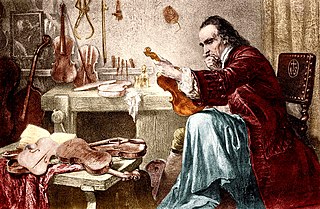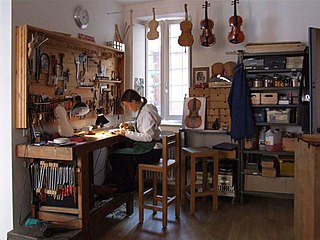Related Research Articles

Antonio Stradivari was an Italian luthier and a craftsman of string instruments such as violins, cellos, guitars, violas and harps. The Latinized form of his surname, Stradivarius, as well as the colloquial Strad are terms often used to refer to his instruments. It is estimated that Stradivari produced 1,116 instruments, of which 960 were violins. Around 650 instruments survive, including 450 to 512 violins. His instruments are considered some of the finest ever made, and are extremely valuable collector's items.

A luthier is a craftsperson who builds or repairs string instruments.

Il Cannone Guarnerius of 1743 is a violin created by the Italian luthier Giuseppe Bartolomeo Guarneri of Cremona (1698–1744).

The violin, viola and cello were first built in the early 16th century, in Italy. The earliest evidence for their existence is in paintings by Gaudenzio Ferrari from the 1530s, though Ferrari's instruments had only three strings. The Académie musicale, a treatise written in 1556 by Philibert Jambe de Fer, gives a clear description of the violin family much as we know it today.

Bartolomeo Giuseppe "del Gesù" Guarneri was an Italian luthier from the Guarneri family of Cremona. He rivals Antonio Stradivari (1644–1737) with regard to the respect and reverence accorded his instruments, and for many prominent players and collectors his instruments are the most coveted of all. Instruments made by Guarneri are often referred to as Del Gesùs.

Gasparo da Salò is the name given to Gasparo Bertolotti, one of the earliest violin makers and an expert double bass player. Around 80 of his instruments are known to have survived to the present day: violins, alto and tenor violas, viols, violones and double basses, violas designed with only a pair of corners, and ceteras.
Francesco Rugeri, also known as Ruger, Rugier, Rugeri, Ruggeri, Ruggieri, Ruggerius, was the first of an important family of luthiers, the Casa Rugeri in Cremona, Italy. His instruments are masterfully constructed. His violins are inspired by Nicolò Amati's "Grand Amati" pattern. Francesco was the first to develop a smaller cello design, which has become the standard for modern cello dimensions. Today, Rugeri's instruments are nearly as renowned as Nicolò Amati's instruments.

Carlo Bisiach (1892–1968) was a violin maker born in Milan, Italy. Bisiach's work contributed to the rebirth of violin making in the region after the difficult times of World War I and World War II. After working with his father Leandro in Milan and then Siena, Carlo established himself at Florence in 1922. The most talented of Leandro's sons, Carlo went on to develop his own style quite separate from the Antoniazzi-derived work of his father and brothers.

Leandro Bisiach was an Italian violin maker, who was born in Casale Monferrato and died in 1945 in Venegono Superiore near Varese.
Andrea Guarneri was an Italian luthier, musician and founder of the Casa Guarneri. He is the most important student of Nicola Amati and grandfather of one of the best luthiers, Bartolomeo Giuseppe Guarneri, del Gesù.

Pietro Guarnieri was an Italian luthier. Sometimes referred to as Pietro da Venezia, he was the son of Giuseppe Giovanni Battista Guarneri, filius Andreae, and the last of the Guarneri house of violin-makers
Pietro Giovanni Guarneri (1655–1720), also known as Pietro da Mantua or Peter Guarnerius of Mantua was a violin maker of the Guarneri family who also worked as a professional musician. Today his instruments are highly regarded, though quite rare. They are played by musicians such as Joseph Szigeti.
Giuseppe Giovanni Battista Guarneri, better known as Giuseppe filius Andrea Guarneri was a violin maker from the prominent Guarneri family of luthiers who lived in Cremona, Italy.
Enrico Ceruti (1806–1883) was an Italian violin maker born in Cremona, known as the last of the great line of violinmakers of Cremona.

Nicola Amati, Nicolò Amati or Nicolao Amati was an Italian master luthier from Cremona, Italy. Amati is one of the most well-known luthiers from the Casa Amati. He was the teacher of illustrious Cremonese School luthiers such as Andrea Guarneri and Giovanni Battista Rogeri. While no clear documentation exists for their being apprentices in his shop, Amati may also have apprenticed Antonio Stradivari, Francesco Rugeri, and Jacob Stainer, as their work is heavily influenced by Amati.
The Lord Wilton Guarnerius, sometimes called the ex-Yehudi Menuhin, is an antique and valuable violin fabricated by Italian luthier Bartolomeo Giuseppe "del Gesù" Guarneri (1698–1744), usually called Guarneri del Gesù. The violin was made in 1742 in the city of Cremona. It was named after Seymour Egerton, 4th Earl of Wilton, a musician, associate of Arthur Sullivan, and 19th century owner of the instrument. It was owned and played by the celebrated violinist Yehudi Menuhin from 1978 to 1999. After Menuhin's death in 1999, the instrument was sold for US$6 million to the collector, David L. Fulton, the highest price paid for a violin to that date.

David L. Fulton is a private collector of Cremonese instruments. Born in 1944, he grew up in Eugene, Oregon, playing the violin from an early age. He studied mathematics at the University of Chicago, and was concertmaster of the University of Chicago Orchestra while he was there.

The Violin Museum, formerly the Stradivarius Museum, is a musical instrument museum located in Cremona. The museum is best known for its collection of stringed instruments that includes violins, violas, cellos, and double basses crafted by renowned luthiers, including Antonio Stradivari and Giuseppe Guarneri del Gesù.

Horace William Petherick (1839-1919) was an artist and illustrator, a violin connoisseur, and a writer. As an artist, four of his works are in public collections in the UK; as an illustrator, he illustrated over 100 books, some of which are still in print, and his work can be found in digital collections at the British Library, the Osborne Collection of Early Children's Books, and the Baldwin Library of Historical Children's Literature; as a violin connoisseur, he owned both a Stradivarius and a del Gesù; and as an author, three of his books are still in print.
Catarina Guarneri, also known as Katarina Rota prior to marriage, was the wife of luthier Giuseppe Guarneri, and a suspected luthier in her own right. Accounts handed down from Carlo Bergonzi II, the grandson of Giuseppe Guarneri, provide evidence that Catarina Guarneri assisted her husband in his work.
References
- ↑ "Guarneri, Giuseppe". Lexico UK English Dictionary. Oxford University Press. Archived from the original on 2022-09-02.
- ↑ "Guarneri". Merriam-Webster.com Dictionary . Retrieved 9 August 2019.
- ↑ "Guarneri". Collins English Dictionary . HarperCollins . Retrieved 9 August 2019.
- ↑ Giuseppe Guarneri del Gesù, 1744
- ↑ Piccolellis, Giovanni de (1885). "Liutai antichi e moderni. Note criticobiografiche".
- ↑ http://www.akutek.info/Papers/AB_Violin_spectra_2003.pdf [ bare URL PDF ]
- ↑ "$18 Million Violin Looking For A Home". National Public Radio. 2010-07-16. Retrieved 2010-07-18.
- ↑ Vivian Goodman (2010-12-06). "Played By Violinists, Bought By Billionaires". All Things Considered (National Public Radio). Retrieved 2013-02-02.